Site menu:

January 2013 Newsletter
Wetland Bird Survey 2010/11 - Part 2.
December Bird News.
Forthcoming Events.
Latest Newsletter.
Wetland Bird Survey 2010/11 - Part 2.
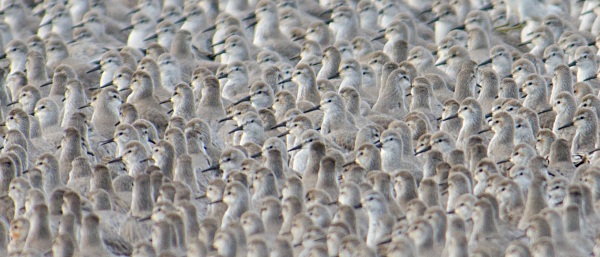
As promised here is the second article
about The Wetland Bird Survey Report -
Waterbirds in the UK 2010/11 - which has
recently been published. The Report can be read online on the BTO
website,
click here:
http://www.bto.org/volunteer-surveys/webs.
This month I'm going into details about four species found in the second half of the Report. The first article, which was about Shelduck, Cormorant, Little Egret and Great Crested Grebe, can be read here.
Knot
The max WeBS count of Knot on the Dee Estuary in 2010/11 was 20,572, this was in December during exceptionally cold weather. The count was well above the five year mean of 15,207 but very close to the long term average for the past 30 years. Knot numbers vary widely from year to year for various reasons, for example in 2000/01 the max count was only 5,672, whereas the following winter they reached a massive 52,762! The reasons for these large swings are discussed in my WeBS and Waders article, with one of the main factors being the height of the tide. On the highest tides the roosts at Point of Ayr, Hoylake and West Kirby are covered by the sea so the Knot have to fly to the next available roost site which is the Alt Estuary (and adjacent Formby shore) and are therefore 'lost' to the Dee Estuary WeBS counts. January 2011 was a good example of this, the WeBS count day coincided with, for January, an exceptional high tide of 9.9m and as a consequence the Dee Estuary count dropped from 20,572 in December, on a 9.2m tide, to just 522 the following month. In contrast the January count on the same day at the Alt Estuary was 48,301, one of the highest ever counts there, although that Alt count will have included birds from the Ribble Estuary where numbers were also low.
Another reason why Knots move away from the Dee Estuary at high tide is disturbance, even in winter a nice sunny day can result in a lot of people down on Hoylake Beach, their main roost. Voluntary Wardens do try and reduce this disturbance but need all the help they can get, if you are interested see the Dee Estuary Voluntary Wardens web page.
Dunlin
Like Knots the max WeBS counts for Dunlin on the Dee Estuary swing widely from year to year, but the five year moving average showed a steady increase from 1989/90 until 2003/04 when there was a max count of 41,679, the highest since 1977. Since 2003/04 there has been a sharp decline with the five year moving average halving so it now stands at just 15,921. Nationally there has also been a decline, thought to be due to birds short-stopping on the Waddenzee with the run of mild winters. As you would expect the cold winters of 2009/10 and 2010/11 saw a rise in numbers nationally but surprisingly the max count on the Dee Estuary in 2009/10 was very low at 9,654. However, numbers recovered in 2010/11 such that the count of 18,574 was the highest since 2005/06.
A footnote: when I wrote my article on North-west Estuaries I commented that 'The count for the Mersey Estuary for 2008/09 was very low but hopefully was just a one off poor winter'. Thankfully that was indeed the case and max counts since then were 44,030 (09/10) and 41,430 (10/11) confirming the Mersey Estuary as the most important site in the country for Dunlin.
Black-tailed Godwit
In 2010/11 the Dee Estuary had the second highest count in the country with a max of 6,188, one of the highest ever counts here. Numbers on the Wash are always the highest with counts of around 10,000 whereas the Dee Estuary, Ribble Estuary, Humber Estuary and Thames Estuary all have similar numbers of birds, usually between 4,000 and 6,000. Colour ringing shows there is much interchange between these sites through the year, in particular between the Dee and Ribble with Marshside RSPB on the latter site often holding several thousand birds.
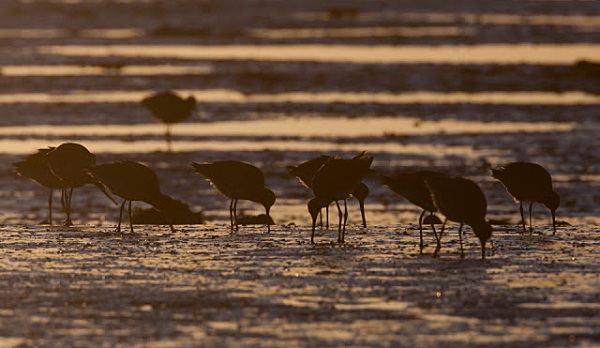
see www.fromthemuddybanksofthedee.com blog.
Sandwich Tern
I always look forward to July and August as these months mark the return of Sandwich Terns to the estuary after their breeding season. They use the estuary as a stop over before moving off to the coast of West Africa for the winter: feeding up, resting and allowing the young to get stronger before undertaking the long journey south. In August 2010 1,669 were counted on the Dee Estuary, the highest number since 2,090 in August 1996. That 2010 count was the second highest in the country. However, the WeBS counts probably underestimate the total number in the estuary and it is likely the true number is usually between 2,000 and 3,000.2011/12 update: Max count was 2004 during August 2011, which exceeds the Internationally Important criteria of 1,700 and confirms the high numbers present on the Dee Estuary during July and August.
Sources of Information for this article:
The Annual WeBS Reports produced by BTO have been consulted extensively over the time period mentioned in the article. See http://www.bto.org/volunteer-surveys/webs.
WeBS (Wetland Bird Survey) data in this article should not be used elsewhere in any way without permission of the WeBS Office. To access official WeBS data please contact the WeBS Secretariat - BTO, The Nunnery, Thetford, Norfolk IP 24 2 PU www.bto.org.
Please note that BTO are
currently looking for WeBS counters for the Mersey Estuary.
If you are
interested please contact them, details on:
http://www.bto.org/volunteer-surveys/webs/about/contact-webs.

Top of Page
December Bird News
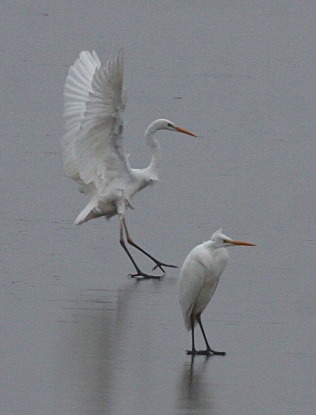 Still
plenty of Waxwings around this month, although they were somewhat
mobile and not sticking to one feeding area, so more difficult to see
than in November. 50 or so were in the Neston
and Parkgate area early in the month with other notable
counts being 13 on the Connah's
Quay Reserve and 30 in Upton, both on the 16th, and 38 in West Kirby on the
24th.
Still
plenty of Waxwings around this month, although they were somewhat
mobile and not sticking to one feeding area, so more difficult to see
than in November. 50 or so were in the Neston
and Parkgate area early in the month with other notable
counts being 13 on the Connah's
Quay Reserve and 30 in Upton, both on the 16th, and 38 in West Kirby on the
24th.Left: Two Great White Egrets during freezing weather at Burton Mere Wetlands on Dec 11th, Paul Brady.
These two Great White Egrets are overwintering and were seen both at Burton and Parkgate during the month.
On the sea was a Grey Phalarope and Black-throated Diver off Hilbre on the 1st, followed by yet another massive count of 719 Great Crested Grebes at Leasowe Lighthouse the following day. A Slavonian Grebe was on the sea at Hilbre on the 17th and 25th, with 19 Red-throated Divers there on Boxing Day.
Brent Geese reached 241 on the 16th, most of these were around Little Eye at high tide with three dark-bellied on West Kirby Marsh. 1,400 Pink-footed Geese were at Parkgate on the 8th but apart from that numbers generally seem to be well down on last winter, so far. Other good counts of wildfowl include 3,100 Pintail, 800 Wigeon and 2,800 Teal, all off Neston Marsh on the 16th.

Knot numbers continue to be really impressive with 30,000 to 40,000 in the estuary with many roosting at Hoylake and West Kirby at high tide. On a still day early in the month they all took to the air not far from were I was at Thurstaston, the noise they made as they took off was just incredible! The ringed bird shown below (with yellow tag ELY) featured in Matt Thomas's article - Tangled up in Knots - Matt saw it last winter at Thurstaston and again in northern Norway in May, so it was great to see it returning again this winter.

Purple Sandpipers reached 21 at New Brighton by the end of the month with similar numbers on Hilbre. There are single over-wintering Greenshanks at both Heswall and Leasowe, with one at New Brighton Marine Lake at the end of the month probably the latter bird. Up to two Spotted Redshanks were also at Heswall.
Two male Hen Harriers continue to be seen flying over the marshes (adult and sub-adult) although ringtails seem to be a bit thin on the ground with may be as few as two present. Eight Short-eared Owls and a Marsh Harrier were at Parkgate during the high tide on the 16th. Three Snow Buntings were at the Point of Ayr early in the month.
Richard Smith.
What to expect in January
If we get some cold weather with snow expect an influx of Pink-footed Geese onto the marshes, at least a couple of thousand, there will also be a couple of Great White Egrets, four or five Hen Harriers, perhaps a Marsh Harrier or two and several Short-eared Owls.
There are two 10 metre tides this month, exceptionally high for so early in the year, but make the most of them as there is only one other as high for the whole of 2013 - in August. Given a west wind and the presence of large number of birds on the estuary and marshes, they promise to be spectacular.
January is a particularly good month for seeing Purple Sandpipers and I would expect over 20 on the pontoon on New Brighton Marine Lake during the highest tides along with hundreds of Turnstones and Redshank, similar numbers of Purple Sandpipers will also be on Hilbre. Wader numbers generally should be high, particularly if the weather on the continent is freezing, and we should continue to get over 30,000 Knot on the estuary and along North Wirral. Other winter goodies should include Snow Buntings, with Point of Ayr being a prime spot, and there is always a possibility of a Shorelark or two. We would expect to see one or two Bitterns and sometimes they show really well at Burton Mere Wetlands.
Lastly, of course, there will still be plenty of Waxwings around although at the moment they seem very mobile and not sticking to one place. I couldn't resist putting this gorgeous photograph of one in this newsletter even though it is just outside the Dee Estuary area.
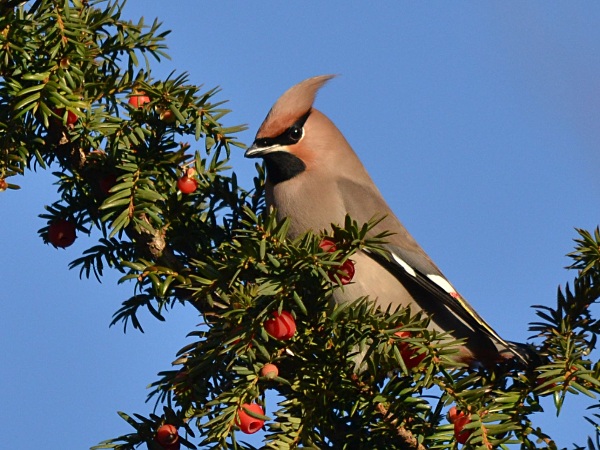
Top of Page
Forthcoming Events
January Highest Spring Tides (Liverpool)
Also
see Tides
page.
12th January, 11.13hrs (GMT), 9.8m.
13th January, 12.00hrs (GMT), 10.0m.
14th January, 12.45hrs (GMT), 10.0m.
15th January, 13.28hrs (GMT), 9.8m.
Forthcoming Events
Organised by the Wirral
Ranger Service , Flintshire Countryside Service and/or the
RSPB:
All these events and walks have bird interest, even those not
advertised specifically for birdwatching. No need to book for these
events unless specified - please check below.
Also see 2012 Events Diary.
Skydancers at Parkgate - 12 noon until dusk.
Skydancer is an exciting new four-year project aimed at raising awareness and promoting the conservation of hen harriers in the north of England.
The Dee Estuary is a vital wintering ground for these amazing birds and is the best place to see them from October through to March.
Most people have never seen a hen harrier, but once seen it is rarely forgotten. This bird is a beautiful, agile hunter, and its aerobatic sky dances are among the most awesome spectacles in nature.
Unfortunately, with only a handful of pairs still breeding successfully in England, the hen harrier is currently a species on the brink.
Come along to Parkgate to find out more about the hen harrier story and what you can do to help save hen harriers before it's too late!
Look for the RSPB Love Nature marquee along the main promenade at Parkgate where friendly staff and volunteers will be with telescopes and binoculars plus family activities, free information and more: http://www.rspb.org.uk/skydancer/
Directions: The "Donkey Stand" opposite Nicholls Ice-cream shop on The Parade (B5135), Parkgate, Cheshire.
Saturday 12th January, High tide Birdwatch, Hoylake Shore.
9:30 am start. High tide 1113 am, 9.8m.
You will discover why Wirral’s foreshore is an internationally protected site when you join the Dee Estuary Voluntary Wardens, Coastal Rangers and the RSPB on this winter birdwatch at Hoylake. Dress warmly and bring binoculars if you have them.
No need to book.
Meet at King’s Gap, Hoylake.
Please ring (0151) 648 4371 if you need more information.
DUE TO THE BAD WEATHER THE CHASING BLACKWITS TALK HAS BEEN REARRANGED FOR Jan 25th.
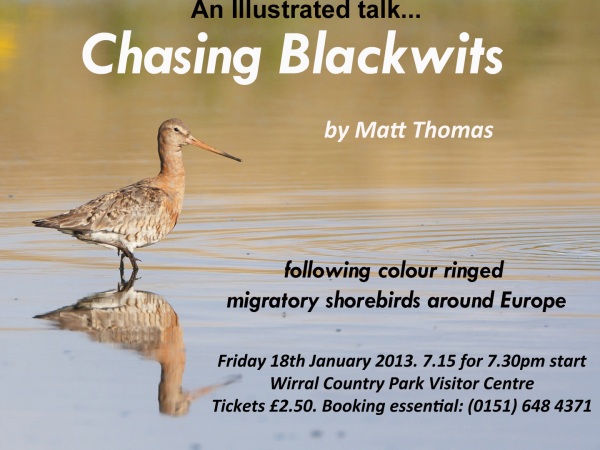
Saturday 19th January, Start 1pm, Wardens Wetland Welly Walk at RSPB Burton Mere Wetlands.
Price: £8 non-members, £4 members - Booking essential.
An exclusive chance to go behind the scenes at Burton Mere Wetlands and learn how we manage the landscape here to benefit wildlife.
Access to parts of the reserve which are normally off-limits will give a unique insight into the management of habitats for wintering wildfowl and breeding waders.
This 2+ hour walk will start in the main visitor reception and finish with a hot drink and biscuits.
Places are limited so booking is essential - Telephone 0151 353 8478.
NB This a a long walk over rough, boggy terrain so decent fitness and wellies are a must.
See http://www.rspb.org.uk/events/details.aspx?id=tcm:9-337467 for further details and map.
Tuesday 29th January - 8:30am - 4:30pm, Digital Wildlife Photography on Hilbre Island.
Ron Thomas A.R.P.S. will be leading this course in digital wildlife photography focusing on wading birds, wildfowl and seals.
There will be practical instruction around the island and software tuition in the day room (with refreshments).
This is a full day course staying on the island over high tide.
Camera, batteries, packed lunch, warm waterproofs and strong footwear required.
Places are limited and booking is essential (a charge applies)
For further enquiries contact 0151 648 4371.
Saturday 2nd February - 10:00am - 3:00pm, World Wetlands Day - Wirral Country Park.
The Visitor Centre at Thurstaston overlooks the internationally important wetlands of the Dee Estuary.
We will be marking World Wetlands Day with a day of activities at the Centre including a slideshow at 11.00am and a guided walk at 12.30pm.
There will be experts on hand to answer bird watching questions and there will be stalls with information about local groups.
Warm waterproofs, strong boots and binoculars are recommended for the guided walk.
For further details telephone ring 0151 648 4371. No need to book.
Sunday 3rd February - 10:30am - 12:30pm, Winter Birds at Royden Park.
Join the Ranger and spend some time looking at our resident winter birds and gaining some hints on feeding and nest box locations.
Meet at Coach House/Court Yard at Royden Park.
Sorry no dogs.
For further enquiries ring 0151 677 7594.
Tuesday 12th February - 8:00am - 4:00pm, Hilbre Island - Purple Patch.
Each winter Hilbre Island plays host to a small troop of Paurple Sandpipers.
These small waders are a real highlight of Hilbre's winter avifauna and are the target species for this guided walk across to the islands.
We will also look for other Hilbre winter specials like Brent Geese, Divers and Grebes.
There will also be a short slideshow and talk in the day room.
This is a full day trip, staying on the island over high tide.
Places are limited so booking is essential, please ring 0151 648 4371.